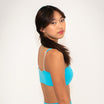Promoting Breast Health for Teenage Girls

Taking care of your body is important, and that includes understanding breast health. As a teen, your body is going through a lot of changes, and it can sometimes feel confusing. But learning how to check in with yourself and know what’s normal can make a big difference in feeling confident as you grow.
In this article, we’ll break down everything you need to know, including an easy self-check guide, common breast changes during puberty, busting myths about breast health, and more. Plus, we’ll talk about how Bleuet, a brand that’s all about giving teens comfort and confidence, can help you find the right bras to support you along the way.
Why Taking Care of Your Breast Health Matters

Breast health is more than just keeping an eye out for changes — it’s about understanding how your body works as you grow. During your teenage years, your breasts will go through natural changes, and getting familiar with how they feel can help you build a sense of awareness. This kind of awareness can help you detect any unusual changes early on, which is key to staying healthy.
By focusing on breast health now, you’re setting yourself up for long-term health and confidence. And getting yourself clued up — such as learning the right way to do self-exams — can make a big impact down the road.
How to Check Your Breasts: A Simple Self-Exam Guide
Doing regular self-exams is one of the best ways to stay familiar with your breasts and notice any unusual changes early on. Here’s an easy, step-by-step guide to help you get started:
- Pick the right time: The best time to do a self-exam is the week after your period ends, when your breasts are least likely to be swollen or tender. If you don’t have your period yet, just pick a consistent day each month.
- Start by looking: Stand in front of a mirror with your arms at your sides. Look at your breasts and check for anything unusual, like changes in color, shape, or skin texture (such as dimpling or redness). Check that your nipples are not inverted (pushed inward) instead of pointing out. Then, press your hands down on your hips and check from that position, too. Also, raise your arms above your head and check again. During this part, also check for any fluid coming out of one or both nipples, including blood and watery, yellow, or milky liquid.
- Inspect lying down: This next step is done lying down because breast tissue spreads out, making it thinner and, therefore, much easier to inspect. Lie down on your back with one arm behind your head. With the opposite hand, use the pads of your fingers to press gently but firmly on your breast in small, circular motions. Move around your entire breast in a pattern, from the outer edges to the center. The area you need to check is from the collarbone to the top of your abdomen (and includes your armpits).
- Repeat on the other side: Switch sides and repeat the same process for your other breast. Ensure that you use differing pressure levels so that you can thoroughly feel all of the tissue.
- Feel while sitting or standing: Many girls and women find this step easier to do when the skin is wet and slippery, so it can be a good idea to do this while in the shower. Inspect using the same hand movements as when you were lying down.
- Make it a habit: Try to check your breasts once a month. The more familiar you are with how your breasts normally feel, the easier it will be to notice any abnormal changes.
If you do notice something that feels different or doesn’t seem normal, it’s always a good idea to talk to a parent or doctor for advice. Remember, most changes don’t mean anything serious, but it’s always better to be safe and check in!
What About Breast Health Screenings?

As a teen, you may not need to worry about breast health screenings just yet, but it’s important to know what they are and why they matter for the future. Breast health screenings, like mammograms, are tools used to detect any early signs of breast cancer or other issues. These screenings aren’t generally necessary until your 40s or 50s, but building awareness now can prepare you for later.
That said, it’s still a good idea to pay attention to your body. If you notice anything unusual — like pain, nipple discharge, or lumps — it’s always best to talk to a parent or doctor. They might recommend further testing, even at a young age, just to make sure everything is normal.
Common Breast Changes During Puberty: What’s Normal and What’s Not

During puberty, your body is going through all sorts of changes, and your breasts are no exception. This is totally natural and can vary from person to person. It’s totally understandable to be confused about what is normal and what is not. Here are some common breast developments you might notice as part of maintaining awareness of your breast health:
- Breast Buds: One of the first signs of puberty is the development of breast buds — small lumps that form under your nipples. This is completely normal and part of your body’s growth process.
- Growth and Tenderness: As your breasts grow, you may notice tenderness or soreness, especially around your period, due to changing hormones. You may also feel itchiness, tingling, or achiness in your chest, and your nipples may swell. These are usually nothing to worry about.
- Asymmetry: It’s very common for one breast to grow faster than the other. Many girls notice one breast is slightly larger or shaped differently than the other, and it often evens out over time. However, it is completely normal and quite common for breasts to be different sizes once fully developed, too.
- Changes in Nipple Appearance: Your areola (area of dark-colored skin surrounding the nipple) may get larger and darker, and the nipples might push out. These changes are all part of normal development.
- Discomfort: You may also feel discomfort or pain when taking part in physical activities, such as running or playing a sport.
While most of these changes are part of puberty, it’s important to know when to talk to a doctor. If you notice any of the following, it’s a good idea to check in with a healthcare professional:
- Persistent pain in your breast that doesn’t go away or is getting worse and seems unconnected to your period.
- Lumps that feel hard or don’t move when you press on them.
- Hot, red, or swollen breasts (remember they may swell at times due to your period).
- Discharge from your nipples.
Top Tip: For more insights on breast development and puberty in general, check out our articles on breast development by age and stages of puberty girls!
Healthy Habits to Support Your Breast Health

Taking care of your body through healthy habits can have a positive impact on your breast health, both now and in the future. Here are some simple ways to support your overall health and well-being:
- Eat a Balanced Diet: What you eat plays an important role in keeping your whole body healthy. Try to include a range of fruits, vegetables, low-fat dairy, whole grains, and lean proteins in your diet. Foods that are rich in antioxidants, like berries and leafy greens, are great for supporting overall health. Healthy fats, such as those found in avocados and nuts, can also be beneficial.
- Stay Active: Regular physical activity helps you keep a healthy weight and supports breast health. Whether it’s a sport you love, dancing, or even taking walks, keeping active strengthens your body and can lower your risk of certain health issues in the future. Aim for at least one hour of activity a day.
- Limit Caffeine: While there’s no direct link between caffeine and breast health concerns, some people notice that cutting back on caffeinated drinks, like soda or coffee, reduces breast tenderness or discomfort.
- Avoid Smoking or Vaping: Smoking and vaping can affect your overall health, including your breast health. While this may seem like a habit to worry about later, avoiding it now can lower your risk of health issues down the road.
- Sleep and Stress Management: Getting enough sleep and managing stress are essential. Make sure to get plenty of rest and find ways to relax, whether that’s through yoga, journaling, or spending time with friends.
- Wear the Right Bra: Wearing a properly fitting bra, especially during sports or physical activities, can reduce discomfort and support breast health. At Bleuet, we offer bras specifically designed for girls, tweens, and teens like you, providing comfort and the right level of support as your body changes!

What Every Teen Girl Should Know About Breast Cancer
The big “C” word is scary, and it’s normal to feel a little nervous when you hear about breast cancer. However, there are a couple of things worth knowing as a teenager:
- Breast Cancer in Teens Is Very Uncommon: It’s important to know that breast cancer very rarely affects teenagers. Most cases occur in women over 40. In fact, less than 5% of breast cancers occur in women under the age of 40[1]. However, learning about it early can help you stay informed for the future.
- Learn Your Family History: If someone in your family, like your mom, grandmother, or aunt, has had breast cancer, this can raise your chances of developing it later in life. Statistics show that 5%-10% of breast cancers are caused by an inherited gene [2]. Knowing your family’s medical history can help you and your doctor make informed decisions about your future breast health.

Busting Breast Health Myths for Teens
There are plenty of myths about breast health floating about, especially during your teen years. Let’s clear up a few of the most common ones:
-
Myth: Wearing a Bra to Bed Can Stop Your Breasts From Growing
This is completely untrue! Wearing a bra to bed won’t affect your breast growth in any way. Your breasts grow as a natural part of puberty, and whether you wear a bra or not while sleeping has no impact on their development. -
Myth: Breast Size Is Linked to Breast Health
The size of your breasts has no effect on your breast health. Whether you have larger or smaller breasts, you should practice the same self-care and awareness to keep them healthy. It is about paying attention to unusual changes, not about size. -
Myth: Exercising Can Cause Your Breasts to Sag
Some people worry that physical activity can make breasts sag over time. The truth is that exercise actually strengthens your muscles and keeps your body healthy overall. Wearing a supportive sports bra will minimize any discomfort during exercise. -
Myth: Breast Pain Always Means Something Serious
Breast tenderness and soreness are often caused by hormonal changes during your menstrual cycle and are usually nothing to worry about. While persistent pain should be checked by a doctor, most breast pain is normal and not a sign of something serious.
Discover Bleuet: Bras Designed With You in Mind

As your body goes through changes during your teen years, having the right kind of support can make all the difference. At Bleuet, we’re focused on giving you bras that provide exactly that while keeping you comfortable and confident.
Here are just a handful of reasons why our bras and undergarments stand out:
- Fit: Breast development is different for everyone, which is why Bleuet offers a wide range of sizes, from eight to 24, and offers support for AA-C cups. No matter where you are on your journey, we’ve got bras that fit perfectly. We also provide many skin-tone options so you can choose the ideal match for your unique complexion.
- Active Lifestyle Support: Whether you’re studying or taking part in a physical activity, you deserve a bra that moves with you. We offer bras with a comfort stretch band that stays put, giving you the support you need without digging in or rolling up.
- Comfort: Your comfort is our priority. That’s why Bleuet bras feature ultra-soft fabrics with minimal seams so that they feel gentle against your skin. With reversible designs and no tags to cause irritation, we have thought of everything to make our bras as comfortable as possible.
- Moisture-Wicking Materials: We use breathable, moisture-wicking fabrics that keep you feeling cool and dry all day long.
- Stretch: Our fabric has a lot of stretch, meaning you can wear our undergarments for longer as you grow and develop. Bleuet bras are designed with teens like you in mind, providing a great fit now and in the future.
- Satisfaction: We currently have over 6,000 five-star reviews (and counting!) from very happy customers.
So, what are you waiting for? Check out Bleuet’s range today and find the perfect fit for your needs!
Final Thoughts
Taking care of your health as you grow is all about building healthy habits. From regular self-checks to staying active to knowing when to talk to a parent or doctor, these small actions can make a big difference in staying on top of your breast health.
Along with these habits, wearing the right bra can provide the comfort and support you need as your body changes. Explore our exciting range of bras at Bleuet today, made for girls, tweens, and teens just like you.
FAQs
How can I make my breasts healthy?
You can support your breast health by doing regular self-checks, staying active, eating a balanced diet, and wearing a properly fitting bra.
What are the signs of unhealthy breasts?
Signs of potentially unhealthy breasts can include persistent pain, unusual lumps, or nipple discharge. If you notice any of these, it’s important to talk to a doctor.
What are the signs of healthy breasts?
Healthy breasts usually feel smooth and firm with no persistent pain or abnormal lumps. Regular self-exams help you understand what’s normal for your body.
References
[1] https://www.medicalnewstoday.com/articles/320533#breast-cancer-vs-normal-development









Leave a comment